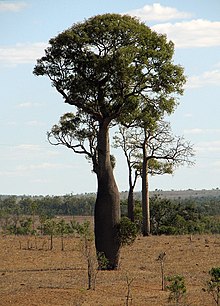Brachychiton rupestris
| Queensland bottle tree | |
|---|---|
 |
|
| Scientific classification | |
| Kingdom: | Plantae |
| (unranked): | Angiosperms |
| (unranked): | Eudicots |
| (unranked): | Rosids |
| Order: | Malvales |
| Family: | Malvaceae |
| Genus: | Brachychiton |
| Species: | B. rupestris |
| Binomial name | |
|
Brachychiton rupestris (T.Mitch. ex Lindl.) K.Schum. |
|
| Synonyms | |
|
Delabechea rupestris T.Mitch. ex Lindl. |
|
Delabechea rupestris T.Mitch. ex Lindl.
Brachychiton delabechei F.Muell.
Sterculia rupestris (T.Mitch. ex Lindl.) Benth.
Brachychiton rupestre orth. var. K.A.W.Williams
Brachychiton rupestris, commonly known as the narrow-leaved bottle tree or Queensland bottle tree, is a tree in the family Malvaceae native to Queensland, Australia. Discovered and described by Sir Thomas Mitchell and John Lindley in 1848, it gained its name from its bulbous trunk, which can be up to 3.5 metres (11 ft) diameter at breast height (DBH). Reaching 10–25 metres (33–82 ft) high, the Queensland bottle tree is deciduous, losing its leaves between September and December. The leaves are simple or divided, with one or more narrow leaf blades up to 11 centimetres (4 in) long and 2 centimetres (0.8 in) wide. Cream-coloured flowers appear from September to November, and are followed by woody boat-shaped follicles that ripen from November to May. No subspecies are recognised.
As a drought-deciduous succulent tree, B. rupestris adapts readily to cultivation and is tolerant of a range of soils and temperatures. It is a key component and emergent tree in the endangered central semi-evergreen vine thickets—also known as bottletree scrub—of the Queensland Brigalow Belt. Remnant trees are often left by farmers on cleared land for their value as shade and fodder trees.
Brachychiton rupestris grows as a succulent tree reaching 10–20 metres (33–66 ft) (rarely 25 metres (82 ft)) in height, though plants in cultivation are usually shorter. The thick trunk is 5–15 metres (16–49 ft) tall, with a 1–3.5 metres (3.3–11.5 ft) diameter at breast height (DBH). It has dark grey bark and is marked by shallow tessellation and deeper fissures. Smaller branches are light green or grey, as are the trunks of immature trees. Like those of all members of the genus, the leaves are alternately arranged along the stems.
...
Wikipedia
